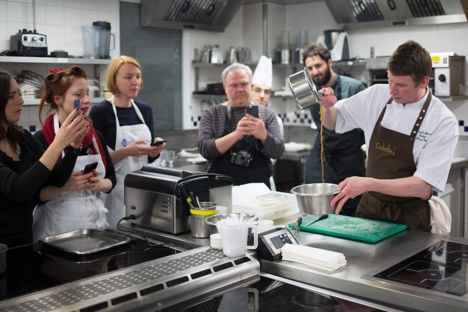
Cook school confidential: cooking sous vide
We invited chef Russell Bateman to the hallowed halls of Le Cordon Bleu to share his expert knowledge on cooking sous vide and how easy and accessible it is to do at home. Take a look at his top tips and why he finds it such an invaluable tool in the kitchen.
Cook school confidential: cooking sous vide
We invited chef Russell Bateman to the hallowed halls of Le Cordon Bleu to share his expert knowledge on cooking sous vide and how easy and accessible it is to do at home. Take a look at his top tips and why he finds it such an invaluable tool in the kitchen.
If you’ve eaten out at a relatively nice restaurant in the past decade, it’s more than likely that something on your plate was cooked sous vide. Ever wondered how chefs get their steaks so perfectly cooked, what the secret is to getting vegetables so tasty or why a particular fillet of fish has such a satisfying texture? In many cases, the answer is a temperature-controlled water bath, a vacuum sealer and some plastic bags.
Until relatively recently, recreating this technique at home was pretty pricey, but in the past few years the kit has come down in price and you can be cooking like a pro for under £200. To spread the word about sous vide and how much of a difference it can make to your cooking, we enlisted Russell Bateman – head chef at Colette’s – to run a workshop with bloggers and journalists at Le Cordon Bleu in London. As well as demonstrating a few ways in which sous vide works best, everyone got hands-on and cooked their own fish dish using the equipment.
‘We’re doing a halibut poached in vanilla beurre noisette with escabeche vegetables and saffron potatoes, which is quite a classical French dish but using modern techniques,’ says Russell. ‘I wanted to cook every element in the water bath, and we only need to make the beurre noisette over the stove, so only one pan is needed. It’s a great way to show people you can cook lots of different ingredients and create different textures using sous vide.’
There are lots of reasons why Russell is a big fan of sous vide (although he says like any cooking method, it needs to be treated with respect and understood), but control is the most important. ‘Sous vide is much more controlled than traditional cooking – you have very little control over how hot a pan gets on the hob – so you won’t get dry or uneven pieces of fish. It also helps the vanilla flavour penetrate right into the halibut, so you get a much more consistent finish. From my point of view it’s all about consistency, and you don’t need the knowledge and skill of an expert chef to pull it off.’
Sous vide tends to be associated with incredible steaks and firm, perfectly cooked fish, but it’s just as effective when cooking vegetables, too. ‘Escabeche and saffron potatoes are both quite expensive ways of cooking vegetables, as traditionally you need lots of saffron and olive oil,’ explains Russell. ‘But with sous vide everything is compacted and the flavours are almost forced into the vegetables, so you need less. All the moisture produced by the veg during the cooking will help with the marinating and cooking, too, because there’s nowhere for it to go.
‘Lots of people cook potatoes and boil the hell out of them until they start falling apart and crumble around the edge, or they’re raw in the middle and cooked on the outside,’ he adds. ‘But potatoes cooked sous vide are under pressure and will always keep their shape. It also means both the colour and the flavour of the saffron will reach right into the middle, instead of just affecting the surface.’
After Russell had finished with his halibut, Le Cordon Bleu’s own chef Eric Bediat prepared one of his own sous vide dishes: celeriac fondant with a cep and walnut nougatine and watercress velouté. By cooking the celeriac sous vide for two hours in walnut oil, the root vegetable was perfect throughout, and the flavour from the oil permeated right through to the centre. It showed how sous vide can take care of ingredients which need precise cooking, while you get on with other things (in this case, the nougatine and velouté).
The finished dishes were a complete success, showing how easy sous vide cooking can be and how it produces incredible results. But Russell had a few tips to offer everyone before they rushed back home to begin planning their next sous vide dinner. ‘Cure your fish before cooking it sous vide either with a brine or salt. Always make sure you’re cooking at safe temperatures, too, especially with things like chicken; use a temperature probe to double check. Don’t be afraid to flash-fry food after it’s been in the water bath to give it texture and flavour – some people do this beforehand but I prefer doing it afterwards to get it caramelised. But the most important thing to remember to get a good bit of kit, use it safely but play with it; cooks use sous vide in all sorts of different ways. I tend to use it to cook vegetables, but I know other chefs don’t do that. Find what you like about sous vide and understand what it’s doing to the food.’

